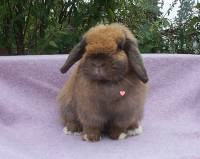Choosing Complementary Rabbits To Breed
 Before jumping right into breeding, let’s take a look at which bunnies should be bred together. Since you are always working to improve the breed, your aim is to produce better and better bunnies over time. To correct the deficiencies in one bunny, breed him or her to a bunny with a strength in the corresponding feature. For example, if you have a doe with narrow shoulders, breed her to a buck with wider shoulders.
Before jumping right into breeding, let’s take a look at which bunnies should be bred together. Since you are always working to improve the breed, your aim is to produce better and better bunnies over time. To correct the deficiencies in one bunny, breed him or her to a bunny with a strength in the corresponding feature. For example, if you have a doe with narrow shoulders, breed her to a buck with wider shoulders.
This advice seems simple enough, but evaluating a Holland Lops for his or her strengths and weaknesses can be very difficult. It took me between one and two years to really understand the Holland Lop type that I was aiming for, let alone be able to evaluate how closely my rabbits conformed to my internal picture of the ideal Holland Lop.
You can improve your evaluation by having your bunny judged a number of times and getting the general consensus among the judges. Never rely solely on the evaluation of one judge. Judges vary greatly in their opinions of the same rabbit and in their familiarity with the Holland Lop. Also, you can ask more experienced breeders to tell you how they see your bunnies. Again, it’s best to ask more than one.
You may find that your bunnies have more than one weakness. You have to ask yourself whether the rabbit has enough strengths to be worth working on or whether it is better to start with better stock to begin with. If you want to work with rabbits with multiple faults, you may like to select one fault to work on until you see improvement in that area and then move on to another area you wish to strengthen.
Fairly early on, I decided that I wanted to shorten my herd and work on curvature. New purchases were made to help me in that area and I made sure that longer bunnies were bred with shorter ones. And I bred bunnies with longer, more narrow muzzles to those with shorter, fuller muzzles with the beautiful curvature I desired. I started seeing positive results right away.
![]()
Next Article: Linebreeding, Inbreeding, and Outcrossing
